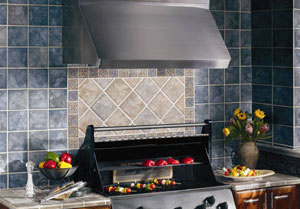Method of Cooking Ventilation
In order for you to make the right choice, it is imperative that you pinpoint the appropriate method of cooking ventilation for your modern kitchen. Your must select the kitchen ventilation system that can effectively remove grease and heat from your cooking appliances, hazardous carbon monoxide from your gas stove and steam from your boiling and dishwashing.
The ideal method of cooking ventilation must be able to remove smoke, reduce humidity and keep the kitchen temperature pleasant. The chosen method must also be able to remove strong cooking smells, which are normally introduced into the kitchen atmosphere when you cook certain dishes.
Requisites of an Ideal Method of Cooking Ventilation
The ideal method of cooking ventilation must provide for the necessary elements that would incorporate extraction and expulsion or recycling of stale air. These are the basic requisites for the cooking ventilation system of modern kitchens of today. Homeowners should consider the safety and health requirements when drawing up the overall plan for their modern kitchen. As a general rule, your paramount concern is to develop a design for a modern kitchen that would provide for a comfortable and safe work setting.
Your choice of the appropriate method would have to take into account the types of cooking equipment and kitchen appliances that you have as well as the overall design and layout of your kitchen. For most modern kitchens, there are actually 2 main options. These are:
- Updraft cooking ventilation method
- Downdraft cooking ventilation method
Updraft Method of Cooking Ventilation
This is easily the more common method of kitchen ventilation in modern homes. The updraft method of kitchen ventilation is applied in range hoods that are installed directly above the stove tops. This type of ventilation hoods sucks up odors and vapors and recycles or expels them. The microwave-range hood combinations are the preferred choice of most homeowners as they score high in terms of space utilization and efficiency. Updraft method of kitchen ventilation is generally more efficient primarily because hot air naturally rises.
Downdraft Method of Cooking Ventilation
The downdraft method of cooking ventilation works by “pulling down” the stale air through vents. This is the appropriate method if your stove top is set on a peninsula or an island. Cooking ventilation systems that adopt this method are usually treated as essential component of the range. In specific kitchen designs, the venting can be retrofitted so that it sucks the stale air from underneath. Majority of homeowners prefer the “hidden” style when it comes to the downdraft method of cooking ventilation.
Most downdraft ventilation systems are outfitted with one or more high-performance fans, and the stale air is driven through a filtration system and into the ductwork, which is normally located underneath the kitchen floor. The downdraft cooking ventilation system must be at least 150 CFM. On the other hand, wall-mounted units must have about 400 CFM, and for the island stove top, it must have about 60 CFM. You also have to take into account the stove placement when you opt for downdraft cooking ventilation system.

